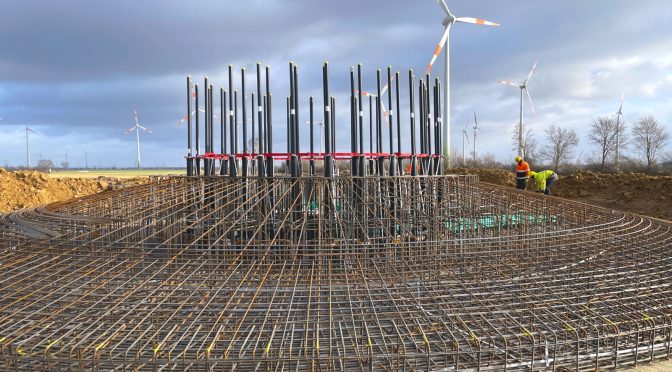Company modernises wind farms in Salzgitter and Peine district. Total capacity to increase from 30.6 to 61.8 MW; electricity production will more than triple. Successful start to construction: First foundation poured for new wind turbine.
Ground frost, gusts of wind, cold – the RWE team braved the adverse conditions. Over the next few weeks, a total of around 100 employees and experts from RWE and its partner companies will be working on two wind farms to dismantle 17 older wind turbines and replace them with 11 new, more powerful ones. By repowering the wind farms in this way, RWE can significantly increase electricity production despite using fewer turbines. This is due to the larger rotor blades being able to capture more wind and produce green electricity even when the wind is weak. At the Lesse and Barbecke sites, the company will increase capacity from 30.6 to 61.8 megawatts (MW).
Katja Wünschel, CEO RWE Renewables Europe & Australia: “43,500 is the number of the day. Once operational, the wind farms will be able to supply the equivalent of 43,500 households with green electricity. Electricity production at both sites will more than triple. Repowering is therefore making an important contribution to the success of the energy transition. But it is not only the climate that benefits, since we voluntarily pay an RWE climate bonus of 0.2 cents per kilowatt hour produced to the local communities. The town of Salzgitter and the municipalities of Lengede, Burgdorf and Söhlde can look forward to a total annual income of up to €280,000, which will be distributed among the municipalities.”
RWE opts for established wind sites in Lesse and Barbecke
The local conditions make the area suitable for wind power, with sufficient distance from the nearest villages and good wind conditions. In Lesse, RWE will replace eleven turbines of the oldest generation (total capacity 19.8 MW) with eight modern turbines with a total capacity of 44.7 MW.
In Barbecke, RWE will replace six existing turbines (total capacity 10.8 MW) with three turbines with an installed capacity of 5.7 MW each (total capacity 17.1 MW). The team has started to set up the construction site and carry out initial road works.
Any repowering project is a logistical challenge. In parallel with the new construction, the old turbines need to remain connected to the grid for as long as possible in order to continue generating green electricity.
Jens Meyer, Project manager at RWE: “We really have our hands full. While we have already laid the first foundation with a diameter of more than 26 metres for the new wind farm in Lesse, we were able to start dismantling the old plant at the same time. We are doing this in the most environmentally-friendly and resource-efficient way possible. We are leaving areas that are no longer required in such a way that they can be used without restriction after dismantling. We also reuse some of the gravel removed from roads and crane pads in the new wind farm.”
How communities benefit from wind power
RWE operates around 90 onshore wind farms in its home market. Involving citizens and local authorities in renewable energy projects is a key element in driving forward the energy transition. It promotes local acceptance. In Germany, the company gives all municipalities with an RWE wind farm a share of the profits. As the RWE climate bonus is paid per kilowatt hour of electricity generated, communities where high-capacity plants are based benefit the most. This creates an additional incentive to replace older plants with modern ones. In Lesse and Barbecke, electricity production will more than triple after repowering. Municipalities can expect to receive up to €280,000 per year of wind farm operation, up from up to €80,000. The additional income can be used, for example, to financially support local facilities such as day-care centres for children, schools and fire brigades. RWE plans to commission all new plants this coming winter.


